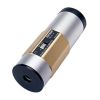Extech Sound Level Meter/Datalogger
The Extech Datalogging Sound Level Meter meets new IEC 61672-1 Class 2 accuracy standard for OSHA and other local and national noise ordinances.
Features
- 30 to 130dB measurement range
- Auto or manual ranging
- AC analog output for connection to an analyzer or recorder
- Free ground shipping
- Expedited repair and warranty service
- Lifetime technical support
- More
The Extech Datalogging Sound Level Meter has an AC analog output for connection to an analyzer or recorder. The high accuracy meter meets ANSI and IEC 61672-1 Type 2 standards. The meter's automatic or manual range is from 30 to 130dB. 99 readings are stored manually and 20M readings via the 2G SD card. User programmable sampling rate is from 1 to 3600 seconds. The built-in PC interface allows users to further evaluate data points. Additonal features include min/max, data hold, and automatic power off with disable function.
- Range: 30 to 130dB (3 ranges)
- Accuracy: +/-1.4dB
- Frequency range: 31.5 to 8000Hz
- Weighting: A and C
- Response time: fast (200ms) / slow (500ms)
- Datalogging: 20M data records using a 2G SD card
- Analog output: AC
- PC interface: USB
- Dimensions: 9.8x2.9x1.9" (250x73x48mm)
- Weight: 18.3oz (520g)
- (1) Meter
- (1) Wind screen
- (1) 2G SD card
- (6) AA batteries
- (1) Hard carrying case
In The News
From Paddles to Phytoplankton: Studying Vermont’s Wildest Lakes
For six months of the year, Rachel Cray, a third-year PhD student at the Vermont Limnology Laboratory at the University of Vermont, lives between a microscope and her laptop, running data. For the other six months, she is hiking and canoeing four of Vermont’s lakes, collecting bi-weekly water samples. Cray studies algal phenology across four lakes in Vermont, US, that have low anthropogenic stress—or in other words, are very remote. Funded by the National Science Foundation Career Award to Dr. Mindy Morales, the lakes Cray researches part of the Vermont Sentinel Lakes Program, which studies 13 lakes in the area and, in turn, feeds into the Regional Monitoring Network, which operates in the Northeast and Midwest US.
Read MoreReimagining Water Filtration: How Monitoring and Science Enhance FloWater Filtration Systems
Over 50% of Americans think their tap water is unsafe , according to the Environmental Working Group (EWG). Other recent surveys have found that number to be as high as 70% of persons surveyed. Whether due to increased public awareness of water quality issues or confusion about how municipal water sources are regulated, there is a clear distrust of tap water in the United States. According to industry expert Rich Razgaitis, CEO and co-founder of the water purification company FloWater, this issue creates a damaging cycle. Razgaitis explained that the health and environmental problems associated with contaminated water aren’t the only issues. As people become increasingly aware that some tap water is unsafe, they resort to bottled water.
Read MoreMonitoring New Hampshire’s Aquatic Ecosystems: Continuous Data Collection in the Lamprey River Watershed
New Hampshire’s aquatic ecosystems provide a range of ecosystem services to the state and region. Resources and services like clean water, carbon storage, climate regulation, nutrient regulation, and opportunities for recreation all depend on New Hampshire’s aquatic ecosystems remaining healthy. Jody Potter, an analytical instrumentation scientist at the University of New Hampshire (UNH), is studying these aquatic ecosystems in hopes of developing an improved understanding of ecosystem services and their interactions with climate change, climate variability, and land use changes. [caption id="attachment_39799" align="alignnone" width="940"] Aquatic sensors in the Merrimack River in Bedford, NH, with I-293 in the background.
Read More










